KẾT QUẢ KHỞI PHÁT CHUYỂN DẠ BẰNG DINOPROSTONE TRÊN THAI PHỤ CÓ CHỈ ĐỊNH CHẤM DỨT THAI KỲ
Nội dung chính của bài viết
Tóm tắt
Đặt vấn đề: khởi phát chuyển dạ là biện pháp được sử dụng rộng rải trên thế giới cũng như Việt Nam. Tỷ lệ sử dụng chung được ghi nhận là 9,6% trên thế giới. Mục tiêu nghiên cứu: đánh giá kết quả khởi phát chuyển dạ bằng Dinoprostone trên thai phụ có chỉ định chấm dứt thai kỳ tại Bệnh viện Phụ Sản Thành phố Cần Thơ. Đối tượng và phương pháp: nghiên cứu mô tả cắt ngang trên 130 thai phụ có chỉ định chấm dứt thai kỳ bằng Dinoprostone tại Bệnh viện Phụ sản Thành phố Cần Thơ từ 5/2020 – 8/2022. Sau 24 giờ rút Dinoprostone tiến hành đánh giá kết quả khởi phát chuyển dạ thành công khi chỉ số Bishop tăng ≥ 3 điểm, cổ tử cung ≥ 3 cm và theo dõi những dấu hiệu bất thường trong quá trình khởi phát chuyển dạ. Kết quả: tỷ lệ khởi phát chuyển dạ thành công là 89,2%; thai từ 37 – 39 tuần có tỷ lệ thành công là 100%; Bishop > 2 điểm có tỷ lệ thành công 94,1% so với Bishop ≤ 2 điểm là 80%; chỉ số Bishop trung bình trước khi đặt thuốc là 2,92 ± 0,88 điểm; sau khi đặt thuốc là 8,5 ± 2,5 điểm. Thời gian khởi phát chuyển dạ trung bình 11,91 ± 6,19 giờ. Một số tác dụng bất lợi khi khởi phát là cơn co cường tính 7,7%; nôn ói 3,9%; nhịp tim thai bất thường 6%. Kết luận: khởi phát chuyện dạ bằng Dinoprostone là phương pháp hiệu quả, an toàn và có tỷ lệ thành công cao.
Chi tiết bài viết
Từ khóa
khởi phát chuyển dạ, Dinoprostone
Tài liệu tham khảo
2. Phạm Chí Kông, Bùi Thị Viễn Phương (2021), Nghiên cứu hiệu quả khởi phát chuyển dạ bằng Propess đặt âm đạo. Tạp chí Phụ sản, tr. 47-53.
3. Nguyễn Bá Mỹ Ngọc, Phạm Việt Thanh (2013), So sánh hiệu quả khởi phát chuyển dạ của prostaglandin E2 và ống thông foley ở thai ≥ 37 tuần thiểu ối. Tạp chí Y học thành phố Hồ Chí Minh, Vol. 17 (1), tr. 149 – 155.
4. Đỗ Thị Minh Nguyệt (2019), Nghiên cứu đặc điểm lâm sàng, cận lâm sàng, và kết quả khởi phát chuyển dạ bằng Propess trên sản phụ có chỉ định chấm dứt thai kỳ tại Bệnh viện Phụ Sản Thành phố Cần Thơ. Đề tài nghiên cứu cấp cơ sở, Bệnh Viện Phụ sản Thành phố Cần Thơ.
5. Huỳnh Nguyễn Khánh Trang, Tăng Trường Bản (2021), Hiệu quả của Propess làm chín mùi cổ tử cung và khởi phát chuyển dạ trên thai trưởng thành đủ tháng tại Bệnh viện Hùng Vương. Tạp chí Y học TP. Hồ Chí Minh, 25(1), tr. 238-243.
6. Hiroaki, et al (2021), Efficacy and safety of controlled‐release dinoprostone vaginal delivery system (PROPESS) in Japanese pregnant women requiring cervical ripening: Results from a multicenter, randomized, double‐blind, placebo‐controlled phase III study. Journal of Obstetrics and Gynaecology Research, Vol 47.1, pp. 216-225.
7. Shruti J Shetty et al (2022), Comparative study of Foley’s catheter and prostaglandin E2 gel for pre-induction cervical ripening. Asian Journal of Medical Sciences, Vol 14 (4), pp. 112 – 117.
8. Yair Daykan et al (2018), Prediction of the efficacy of dinoprostone slow release vaginal insert (Propess) for cervical ripening: A prospective cohort study. Journal of Obstetrics and Gynaecology Research, 44.9 p1739-1746.


